History is full of dramatic conflicts where the capricious tide of events could have turned the outcome in either direction. A mistimed cavalry charge, a careless tactical blunder, a change in the wind direction. What if Napoleon hadn’t wavered at Waterloo? How close did the Normans come to losing the Battle of Hastings? What would the United States look like today if Confederate general Robert E. Lee had routed the Union army at Gettysburg?
Here are 10 well-preserved battlefields where you can ponder these and other such questions.
Ypres, Belgium (1914–1918)
Simply uttering the name of this diminutive Belgian city conjures haunting images of World War I. Unlike other well-known sites of “the war to end all wars,” Ypres suffered not one but five battles—all bloody, costly affairs marked with the macabre motifs of the era: rat-infested trenches, poison gas, cratered tracts of no man’s land, and primitive tanks clawing laboriously through mud. Most of the action centered on the Ypres Salient, a semicircular dent in the front line surrounded by low hills. While the Allies occupied the salient, the Germans enjoyed strategic advantage on the ridges. Although small tracts of territory changed hands as the war wore on, the front line never advanced more than six miles in more than four years. Casualties, meanwhile, surpassed one million, the bulk of them sustained during the savage Third Battle of Ypres, better known as Passchendaele.
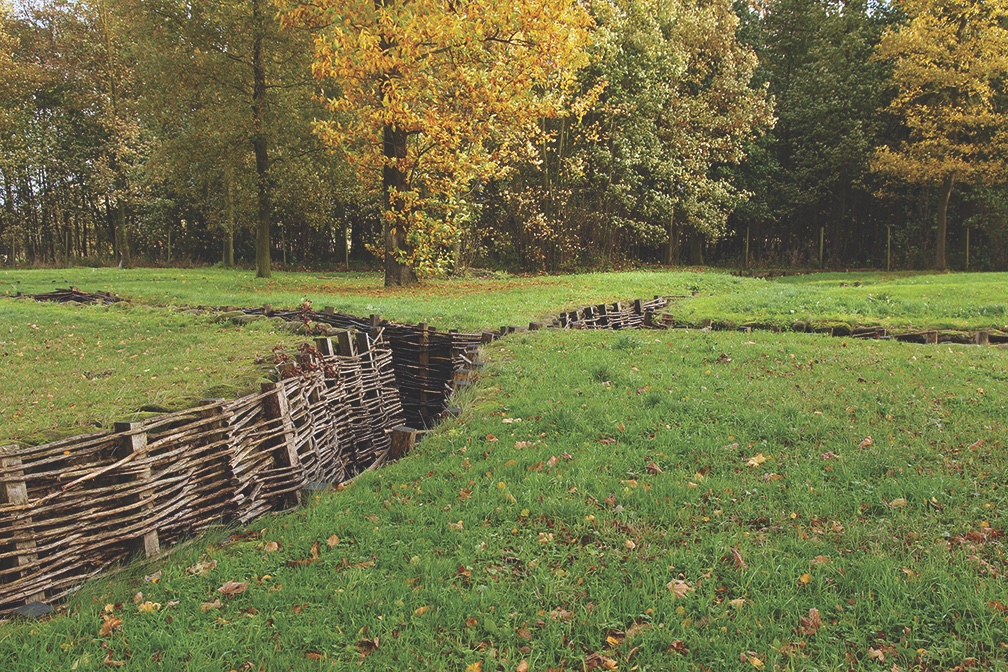
Ypres offers plenty of poignant monuments today, including several important war cemeteries. With more than 11,000 graves (many of the dead are unknown), Tyne Cot is the largest cemetery for Commonwealth forces in the world. On the edge of the city, the Menin Gate is an arched memorial where a bugler plays “The Last Post” every evening at 8. Two local museums offer a multisensory rendering of events by using film, sounds, and exhibits. The Memorial Museum Passchendaele 1917 displays a reconstructed trench (without the rats and lice) while the In Flanders Fields Museum is encased in Ypres’ 13th-century Cloth Hall, meticulously rebuilt after being largely destroyed in the war.
Normandy, France (1944)
Synonymous with Operation Overlord, or D-Day as it is widely known, the expansive beaches of Normandy bore witness to the largest seaborne invasion in recorded history. Beginning soon after dawn on June 6, 1944, a flood of more than 150,000 Allied troops stormed Utah, Omaha, Gold, Juno, and Sword Beaches on the north coast of France.
Of the five, the fiercest fighting took place at Omaha, the second beach from the west. “Bloody Omaha,” as it became known, is a four-mile crescent of sand between Colleville-sur-Mer and Vierville-sur-Mer. A combination of U.S. infantry divisions and ranger battalions assaulted the shores but were pummeled by a terrifying German resistance. Lunging from their amphibious landing craft, many in the first wave of soldiers were mowed down before they even reached the shore. Ultimately, the fight for control of the beach took 18 hours and cost an estimated 2,000 American and 1,200 German lives.
Omaha today is overlooked by the Normandy American Cemetery and Memorial, a field of nearly 10,000 white marble crosses and Jewish stars, a scene that bookends the movie Saving Private Ryan.(The beach-storming scenes were filmed in Ireland.) Equally evocative are the cliffs, to the west, of Point du Hoc, an exposed promontory scaled on D-Day by daring U.S. Rangers using ropes and ladders. Huge craters from aerial and naval bombardments still deface the breezy clifftop, while sophisticated observation bunkers testify to an erstwhile German presence.
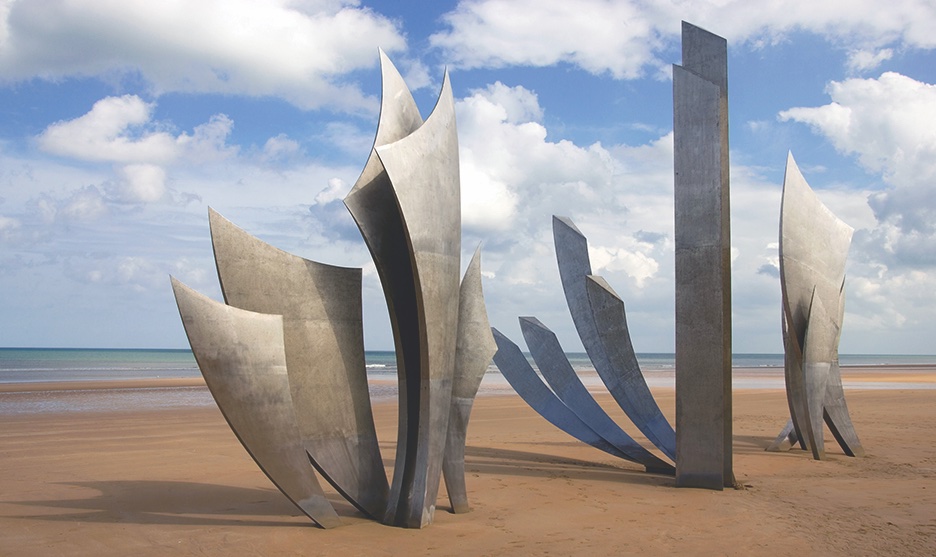
It’s also worth gravitating 11 miles east of Omaha to the small seaside town of Arromanches-les-Bains that abuts Gold Beach. This seemingly innocuous stretch of sand, taken by the British on D-Day, was the site of the ingenious Mulberry Harbors—prefabricated landing ports towed across from England. Parts of the Mulberrys can still be seen both on the sand and offshore, while the beachfront Musée du Débarquement explains more about their deployment and use.
Caen’s Memorial Museum (Le Mémorial—Un Musée pour la Paix), one of the best World War II museums in the world, pays special homage to the 100-day battle for Normandy, in which 20,000 French civilians were killed.
Waterloo, Belgium (1815)
It countered Napoleon’s short-lived comeback, ushered in a protracted era of peace, and muzzled the power of France for a generation. Stamped in fame and infamy, the Battle of Waterloo changed the course of history and became a byword for defeat against a stronger opponent. Raging for 10 hours on the rain-soaked fields of central Belgium, nine miles south of Brussels, the dramatic confrontation pitched the boldly aggressive Napoleon Bonaparte against the adaptive and defensive Arthur Wellesley, First Duke of Wellington.
Wellington’s victory was no foregone conclusion. After escaping incarceration on the island of Elba, Napoleon assumed command of a more experienced army, but he needed to act decisively to dent the muscle of Wellington’s Seventh Coalition awaiting Prussian reinforcements. In a rare tactical blunder, Napoleon vacillated in the wet conditions, giving Wellington time to regroup on a partially concealed “reverse slope” and hold off the French until the Prussian army arrived to support him later in the afternoon.
After the battle Waterloo quickly became a pilgrimage site for grievers and gloaters alike. In 1817 a classical column was raised in honor of Lieutenant Colonel Alexander Gordon, a Scottish officer who died from injuries incurred on the battlefield. Three years later, the iconic Lion’s Mound, an artificial hill fitted with 226 steps, was molded out of the surrounding soil. On its summit, a statue of a lion atop a plinth marks the spot where a musket ball felled Wellington’s young commander, Prince William of Holland, on that fateful day. (He miraculously survived.) A small rotunda at the base of the mound is decorated with a battle panorama painted by Louis Dumoulin in 1912 on 14 canvases that were then sewn together. In 2015, on the 200th anniversary of the Battle of Waterloo, an $11 million underground museum was opened on the site, with uniforms, maps, and an epic 3-D film that hurls you into the middle of a cavalry charge.
Hastings, England (1066)
When it comes to crucial dates in British history, few are as immortal as 1066, the year of the Battle of Hastings, the existential face-off between England and France that marked the last time the British Isles were successfully conquered by a foreign power.
Immortalized in the Bayeux Tapestry, a 77-yard-long embroidered cloth that now hangs in a museum in Normandy, the battle cast Saxon king Harold II against the ambitious prince William, “The Bastard of Normandy.” The prize was the hotly contested English throne, ultimately won by William (since known as William the Conqueror).
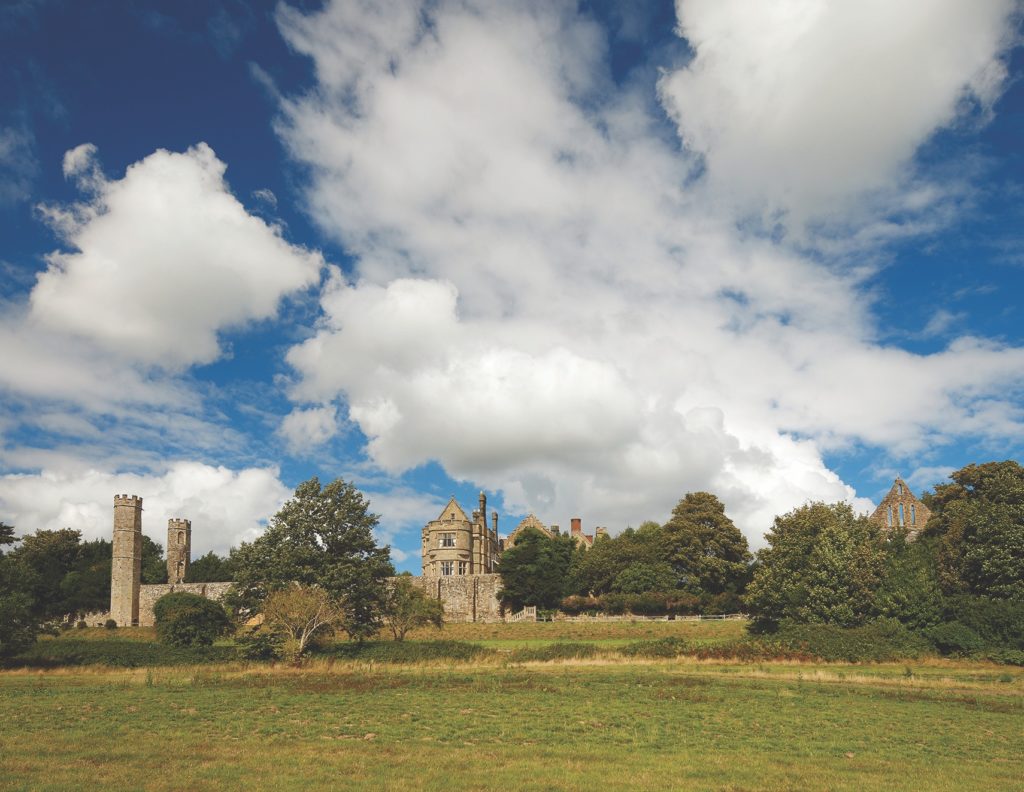
Accounts of the battle are murky. The two most heavily touted legends claim that Harold was killed when an arrow struck him in the eye and that the Normans won by feigning a retreat that drew the overzealous English into hot pursuit, thus breaking their lines.
You can contemplate the theories at the pastoral battle site seven miles north of Hastings, near the aptly named town of Battle in Sussex, where in Norman times William built an abbey on the field of his victory. These days the 11th-century Battle Abbey is in ruins (courtesy of Henry VIII), while a more grandiose twin-towered gatehouse completed in 1338 rises in front of it and contains a museum and rooftop viewing platform.
Gettysburg, Pennsylvania, United States (1863)
Gettysburg was the stage for the most important and costly battle in U.S. history. Waged over three days in July 1863, the heavyweight Civil War confrontation is as famous for President Abraham Lincoln’s laconic battlefield speech, made four months later, as the battle itself.
Often considered the turning point in the American Civil War, the Battle of Gettysburg cast the Confederate forces of Robert E. Lee against the Union army of George G. Meade in what was Lee’s second and boldest attempt to attack the North.
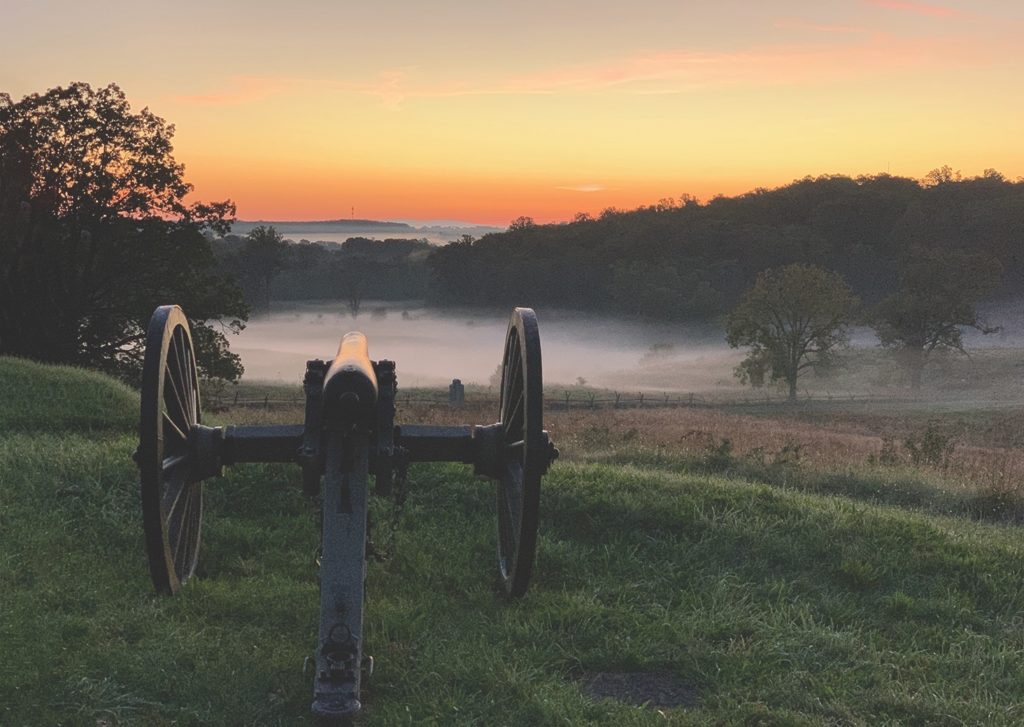
It was the Confederates who seized the initiative, attacking the Union army on the first day and driving the Yankees back from ridges north and west of the town of Gettysburg to Cemetery Hill, where they re-formed in a defensive fishhook. By day two, the fighting had become more intense, with as many as 100,000 troops slugging it out with artillery barrages and bayonet charges. On day three, Lee, after unleashing a massive artillery bombardment, sent 12,000 Confederate soldiers directly at the Union line in what became known as Pickett’s Charge. The Union troops were ready. Employing a 19th-century version of Muhammad Ali’s rope-a-dope trick, they absorbed most of Lee’s shelling while conserving their own cannons. As the Confederate infantry rushed forward, they discharged their guns with devastating results. It was a turning point of the battle, and the war. Lee’s forces never recovered and ultimately retreated to Virginia.
In November 1863 Lincoln visited Cemetery Hill and delivered his famous Gettysburg Address, consecrating the still-bloodstained battlefield for posterity.
Few battle sites today are as well preserved and hallowed as Gettysburg. It is one of only nine U.S. national military parks run by the National Park Service. Amid a lattice of peaceful, misty fields that belie the human hell that briefly enveloped them in 1863 are memorials, lookouts, farm buildings, a museum, and more than a thousand monuments and markers. Perhaps the most interactive way to relive battle is through an annual reenactment, usually scheduled for the beginning of July.
Culloden, Scotland (1746)
Nasty, brutish, and short, the bitterly fought Battle of Culloden took place on a bleak moor in the Scottish Highlands where, in a flurry of hail and musket fire, the Stuart dynasty’s dream of reclaiming the British Crown was snuffed out for good. The two main protagonists were rebel Jacobite leader Charles Edward Stuart (aka Bonnie Prince Charlie), and his testier, younger opponent, the callow 25-year-old Duke of Cumberland, son of the British-Hanoverian king, George II.
Charles had landed in Scotland in 1745, backed by the opportunistic French in a bid to snatch the British Throne. He pieced together a fighting force from Jacobite sympathizers and marched boldly into England before his cautious advisers, worried about withering local support, urged him to make a tactical withdrawal. The Duke of Cumberland was sent in hot pursuit, finally catching up with the Jacobites at Culloden, just outside the Highland town of Inverness.

The armies faced off on open ground in what would be the last pitched battle on British soil. Charles initially tried to provoke the British to attack but, changing his mind at the last minute, ordered his army forward instead. In previous encounters, the redcoats had quickly wilted in the face of the charging Highlanders, but this time they held their ground as their gunners mercilessly strafed the uncoordinated Jacobite stampede. Surprised and confused, Charles’s army was ruthlessly destroyed. Those who weren’t killed fled. The injured men left on the battlefield were shown no mercy by the vengeful Cumberland, whose subsequent war crimes earned him the sobriquet “the Butcher.”
The battlefield at Culloden has been meticulously preserved. Home these days to clusters of contented cows and goats, the moor is managed by Britain’s National Trust and is dotted with flags, footpaths, graves, and a memorial cairn. In 2007 the Trust added a state-of-the-art visitor center and museum, which houses archaeological finds, flared Georgian blunderbusses, and a 360-degree theater.
Bay of Pigs, Cuba (1961)
Known as the place where the Cold War nearly got hot, the Bay of Pigs is a sheltered inlet abutting a mangrove swamp in southern Cuba. It was here in April 1961 that a force of 1,400 Cuban exiles covertly trained by the U.S. Central Intelligence Agency landed on a beach called Playa Girón in an attempt to topple the freshly installed regime of Fidel Castro and inspire a counterrevolution.
Given the green light on April 15, 1961, the invasion was an unmitigated disaster. Aiming to destroy the Cuban Air Force on the ground, U.S. airplanes piloted by Cuban exiles mostly missed their intended targets. Crucially, Castro had been told of the onslaught the previous week and had relocated his air force. When the invaders landed two days later, Cuban light aircraft quickly sank their U.S. supply ships and left the entire exile army stranded on the beach. Meanwhile, President John F. Kennedy refused to authorize U.S. air cover for the marooned soldiers. Left to fend for themselves on the beach without supplies or military backup, defeat was inevitable. About 115 were killed in skirmishes; the other 1,190 were captured.
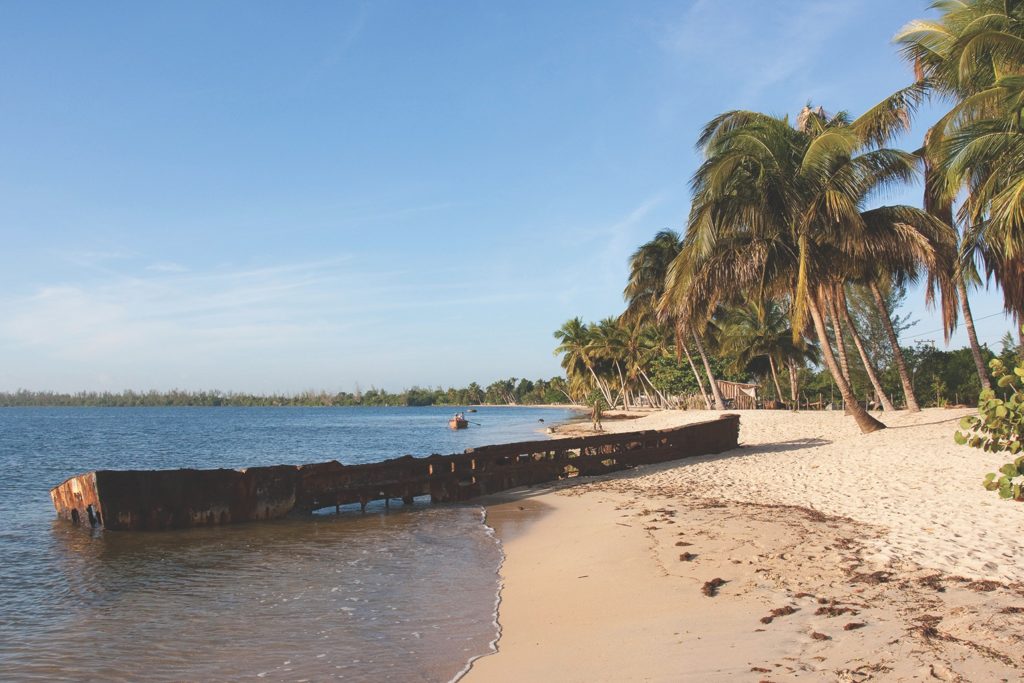
These days, the Bay of Pigs is a major diving destination with crystal-clear water, limestone cenotes, and swim-out walls. The surrounding mangroves have been turned into a national park replete with crocodiles and abundant birdlife. In among the wildlife is a large assortment of battle paraphernalia. The small village of Playa Girón has a well-curated if decidedly propagandist museum dedicated to the landings. A smaller museum in an old sugar factory in the village of Australia, 38 miles to the north, marks the spot where Fidel Castro personally took command of the country’s defense in 1961. Intersecting roads are dotted with monuments to fallen Cuban combatants, and bombastic billboards declare “the first defeat of American imperialism in Latin America.”
Dien Bien Phu, Vietnam (1954)
In 1954, in a crinkled web of mountains in northwest Vietnam, the embedded French colonial forces of Colonel Christian de Castries seriously underestimated the resolve of their tenacious Vietnamese opponents, with deadly consequences. The two-month Battle of Dien Bien Phu mixed mass infantry attacks with old-fashioned siege tactics and dogged trench warfare. Ending in a French surrender, it was the beginning of the end of France’s presence in Indochina and the overture to an even bigger conflict to come.
The French had moved into the mountain outpost of Dien Bien Phu in November 1953 in an attempt to cut Vietnamese supply lines from Laos. Fortified with 14,000 colonial troops, Castries assumed that his small, isolated base propped up by regular air drops would be inaccessible to the Chinese-backed Viet Minh. He was spectacularly wrong.
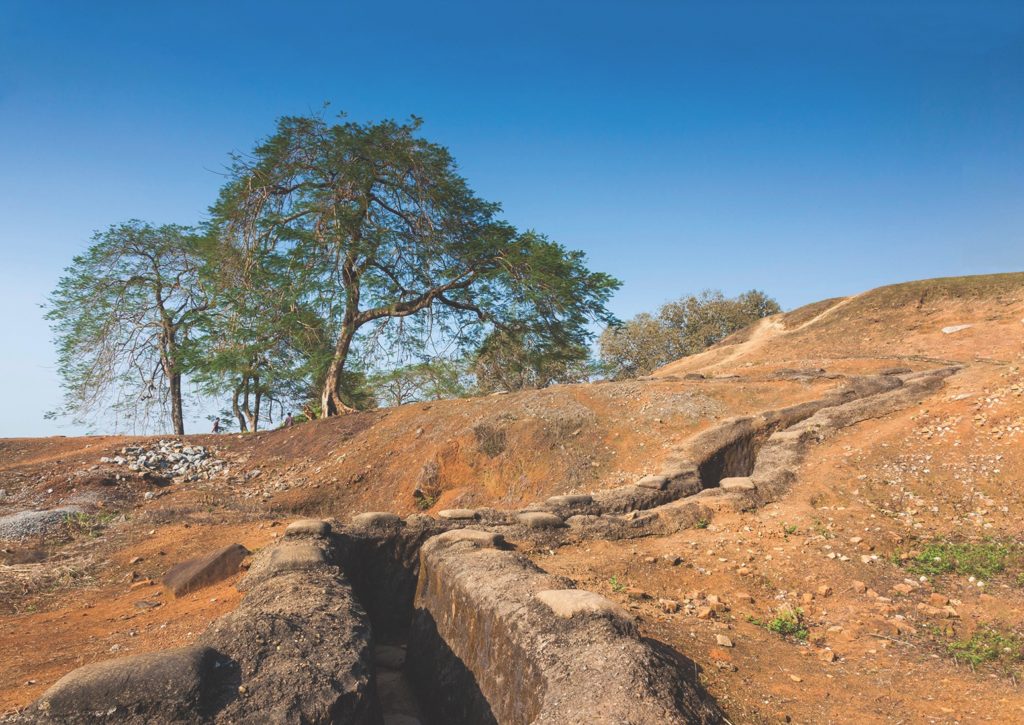
Enlisting the help of more than a quarter of a million Vietnamese civilians, General Vo Nguyen Giap stealthily ferried artillery, supplies, and 50,000 Viet Minh soldiers into the mountains. By March 1954, the French base was surrounded. Initially, Giap ordered mass infantry attacks on French strongpoints around the garrison but, because of high casualty rates, he quickly switched to trench warfare. A series of small probing attacks were ultimately enough to capture the airstrip and choke off the vital French supply line. A final Vietnamese assault overran the garrison on May 6, and Castries surrendered.
Today, the expansive battlefield is scattered with relics and memorials from the 1950s. The Dien Bien Phu Museum features dioramas of the conflict, along with such eclectic items as Castries’s bathtub and a Vietnamese bicycle that carried ordnance into the mountains. Opposite is a well-tended war cemetery heavy with the aroma of burning incense, while nearby A1 Hill, a former French redoubt taken by the Vietnamese, has re-created trenches, a large bomb crater, and an old U.S. tank.
Thermopylae, Greece (480 bce)
It is a testament to Thermopylae’s legend that this epic clash between the Greeks and Persians that reverberated in Central Greece in 480 bce remains a cornerstone of popular folklore 2,500 years later. Contested between a loose alliance of Greek city-states, commanded by Spartan king Leonidas, and the imperial forces of Persia, led by the despotic Xerxes I, it was anything but a fair fight: The Persians allegedly outnumbered the Greeks by as many as 50 to 1. But taking up position in the “hot gates” of Thermopylae, a narrow pass shoehorned between mountains and sea, the Greeks, fronted by an elite Spartan fighting force of 300, held a vital territorial advantage.
For three days the Persians threw everything they had at the iron Spartan wall but were repeatedly beaten back. In the end, they only managed to penetrate the narrow pass when a traitorous Greek, Ephialtes of Trachis, revealed a secret path over the mountains that enabled the Persians to outflank the Greeks and descend on them from behind.
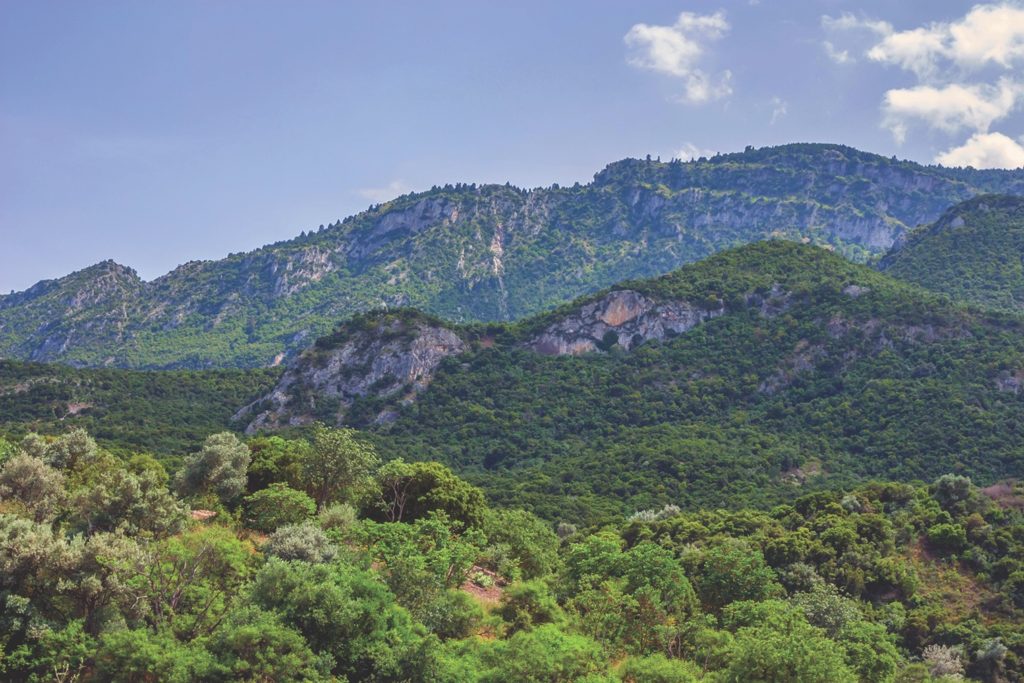
Despite being surrounded and outnumbered, the Greeks refused to yield. Led by the combative Spartans, they proceeded to put up history’s finest last stand, fighting to the death to defend their homeland against ridiculous odds. The bid ultimately failed, and Xerxes went on to overrun most of Greece. But a legend had been born and, for their heroic efforts, Leonidas and his Spartan army were canonized as inspirational martyrs. Innumerable battles in the centuries since have sought to emulate the brave rear-guard action of Thermopylae, from the Alamo to Stalingrad.
Thermopylae would be unrecognizable to Leonidas and the Spartans today. The sea has receded a couple of miles since antiquity, making it difficult to envision the battlefield as it was in 480 bce. A roadside monument features a statue of the Spartan leader holding a shield and brandishing a spear above his head. In the 1990s, a second monument honoring the oft-forgotten Thespians was built alongside. On the other side of the road atop the low Kolonos Hill is the Epitaph of Simonides, an engraving laid there in 1955 to replace several earlier etchings.
Ayacucho, Peru (1824)
A key battle in the uprisings against Spanish rule in South America between 1809 and 1826, Ayacucho rubber-stamped Peruvian independence, prompted the formation of Bolivia, and brought an end to nearly 300 years of Spanish rule. The hero of the hour was Venezuelan general Antonio José de Sucre, a close confidant of Latin American liberator Simón Bolívar, who directed his patriot army against the loyalist forces of the Spanish viceroy, José de la Serna, in the thin mountain air of the Pampa de la Quinua in modern-day Peru. Conditions were harsh, the terrain was rugged, and the stakes couldn’t have been higher.
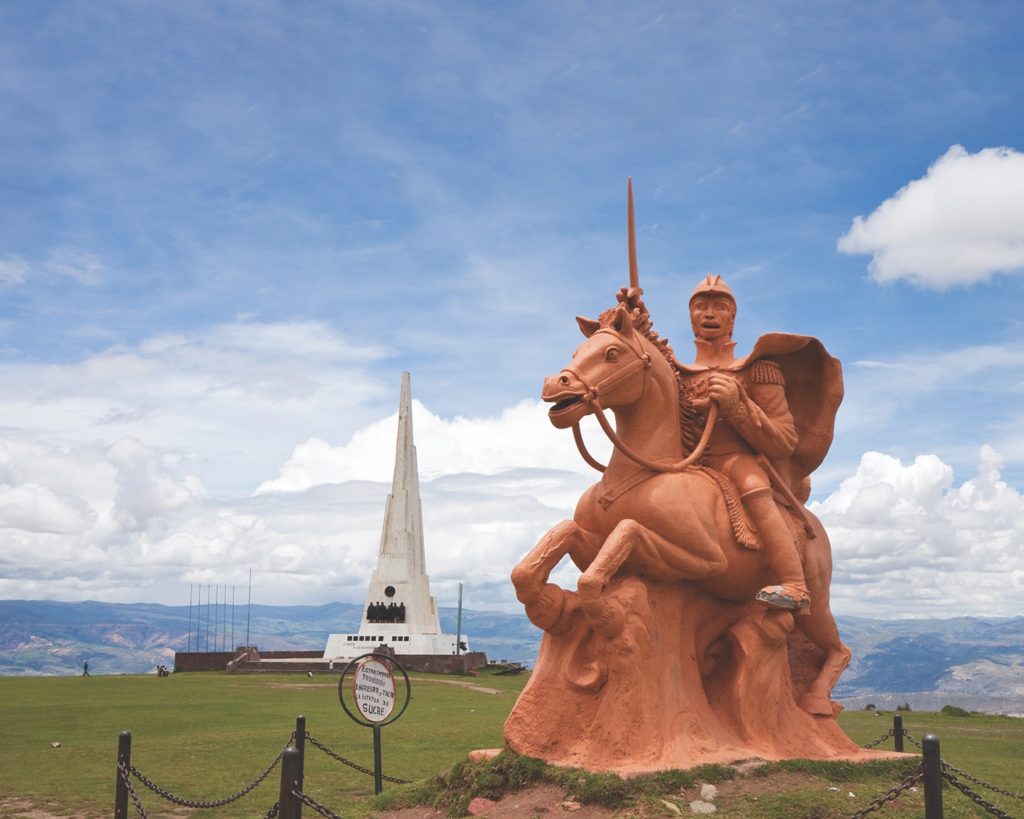
De la Serna had finally caught up with Sucre’s retreating army on a high Andean plateau outside the city of Ayacucho in December 1824. After an unsuccessful attempt to encircle the patriots, he rallied his troops on the Condorcunca hill before launching a careless and disorganized assault on Sucre’s left flank. Strafing the descending cavalry, the patriots held firm before regrouping and preparing their own attack on the right flank, where a calvary countercharge successfully pushed the loyalists back. The Spanish-led army was quickly encircled and more than a dozen of its generals, including the injured de la Serna, captured.
Today, a 144-foot white obelisk marks the site of the battle on the barren pampa, 10,000 feet above sea level. It was built in 1968 and the land around it has been declared a historic sanctuary. Carved scenes from the skirmish adorn the obelisk’s base while, at its foot, four antique cannons point menacingly to the northwest. In the nearby village of Quinua, a small museum contains a reproduction of a painting by Daniel Hernández Morillo that depicts the signing of the Capitulation of Ayacucho on December 9, 1824.

